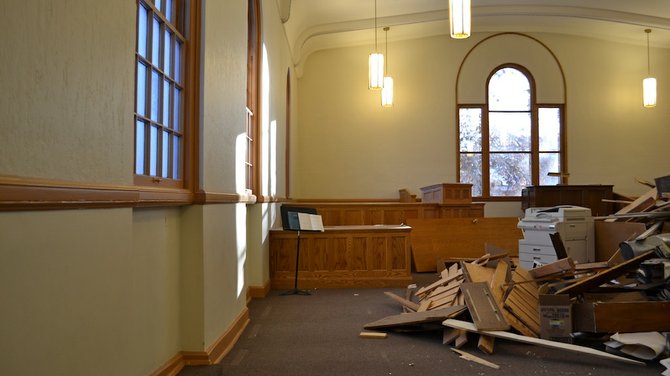Milford is a small town west of Beaver, Utah--population, about 1,500. It was founded in about 1873.

At about 100 W and Center Street stands a beautiful LDS Chapel that was built around 1933 and dedicated in 1940. (The Church History Library photos noted that it was built "about 1900," however, the newspaper article appears to be referring to this chapel, as there are no other chapels in the area.)
(Image Source: Church History Library)
Like any chapel, it's had some changes over the years.
(Image Source: Church History Library)
Finally, in recent decades, the Church built a new chapel at the southern edge of town. The old chapel was eventually leased to Milford City, and it currently serves in that capacity, housing the main city offices.

Unfortunately, the building is old. It needs work. The city council has discussed the various problems that they face with the building--bats, asbestos, and other needed repairs.
For example, the city council noted the problem with the bats in the attic:
"...The entire cleanup done in January 2012 has been reinfected...The bats we have are from Mexico and are creatures of habit so eradicating them completely will be difficult if not impossible. He stated it is a very costly project and this building will be nearly impossible to seal off..." (Source)
Bats alone might not be so bad. But there are other, more concerning issues:
"...there are issues with regulations and asbestos. [The inspector] is not a doctor and he cannot say there are health issues, but felt there more than likely is. He could detect the odors immediately walking through the door. He added there were further problems such as black mold."
Unfortunately, the dilemma faced by the Milford City Council is increasingly common with all old buildings, LDS chapels included. Every year, more and more historic LDS chapels come down--from Teasdale to Paradise to Cedar City--for the same reasons.

The Cedar City 2nd Ward during its demolition. (Image Source)
That's not to say the Milford City Council isn't trying to save the building. They investigated possible funding sources to renovate the building, as it would likely cost hundreds of thousands of dollars. In the March 4, 2015 meeting of the City Council, it was noted that "Mayor [Nolan] Davis does not want to see this building tore down, but with all the different walk throughs with different professionals, he feels it would not be in the city's best interest to put more money into it."
Right now, it looks like the current plan is to have the building vacated by this fall, after which the city will request the funds to demolish it (City Council Minutes, March 4, 2015). In fact, after the first meeting, the city council had already agreed that they would not bother renovating the building; the greater concern was apparently their ability to demolish it, lest it be "another eyesore in the community" (City Council Minutes, October 28, 2014).
The city has even talked with the LDS Church (who still technically owns the building) about whether they want the building back or will help with demolition. The Church offered to deed the building to the city. The city council minutes simply read: "It appears that nobody wants the building" (City Council Minutes, January 20, 2015).
(Source: Google Maps)
So, who's to blame for the presumed forthcoming loss of this building? Everyone and no one, really. You can't blame Milford City for not being able to pour so much money into a building that needs so much work. Nor can the LDS Church really be expected to retain and preserve every single chapel built before 1950. It is a delicate balance, and that means that some chapels lose. Milford will likely be one of them.
That doesn't mean that Latter-day Saints or community members should ignore these historic chapels, allowing them to become invisible buildings. We should do our part to recognize them, celebrate them, and cherish them, for what they are and what they represent: a sacrifice from years past; an undeniable part of Mormon culture, as much as the Mormon Tabernacle Choir, General Conference, or green jello. Architecture is part of the Mormon identity, and we can't let that fade away.
In any case, when a building is lost, the worst thing that can happen is for it to fall without anyone noticing. If we can't save a building, then let's mourn it, memorialize it, and remember it--what it meant to those who built it, brick by brick; what it meant for those who met in it for inspiring sacrament meetings or lighthearted activities or exhausting primary lessons; what it meant for those who saw it as their little piece of Zion, even in the middle of the western wilderness.



This building is amazing!! heart of Milford I can not believe it's is not worth restoring
ReplyDeleteIt is an expensive investment for a small city, so I'm sympathetic to the city council's dilemma. It's just a tough situation all around.
Delete